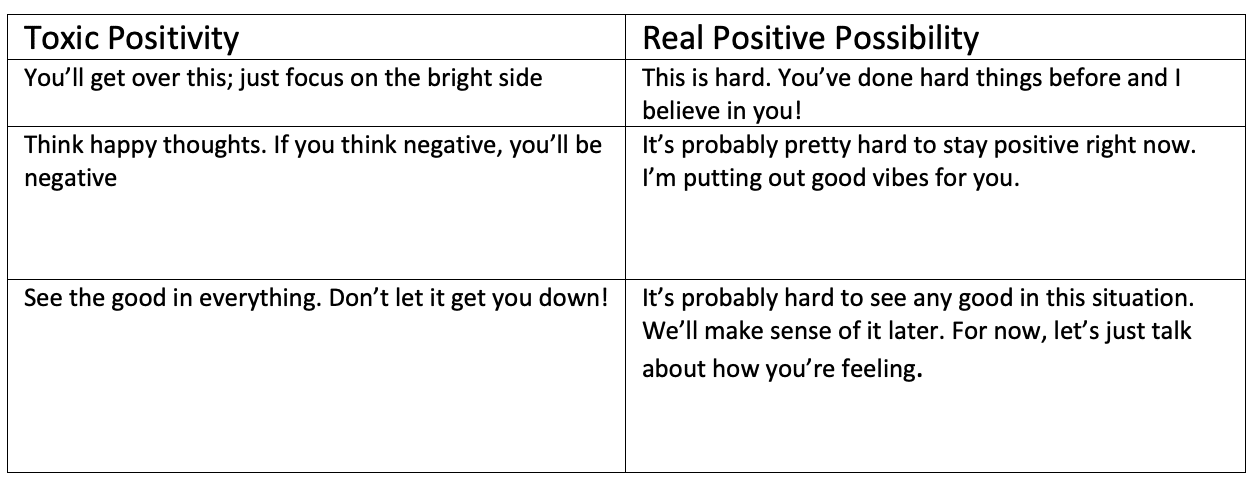At this time of year, we are bombarded with the word ‘happy’ from every direction. From the greetings on festive cards to the banners in shop windows, to the jolly e-mails landing in our inboxes, to the Christmas lights strung across every high street, to the smiling Santas and snowmen and scenes depicting the perfect ‘happy’ family gatherings to the happy messages telling us to have a happy Christmas, a happy holiday, a happy new year and while we’re at it…a happy life! That is an awful lot of ‘happy.’ Maybe too much. Because perhaps we can demand too much happiness of ourselves and others at this time of year. Could it be that narrowing our expectations to this one single emotion might actually not be so good for us? Could it be that other emotions might want to be part of our festive celebrations too?
So, this Christmas, at the end of this extraordinary year full of a range of experiences, difficulties and emotions…at 4D we would like to challenge the idea of it having to only be a ‘happy’ Christmas. Because while many of us might not be able to welcome actual guests into our house this holiday, we can welcome other kinds of guests…the many, many emotions that might just be knocking on our door wanting to come in and join the party.

But why would we want to let difficult emotions in? Who wants to feel sad or lonely or angry? Particularly over the holidays? Good questions. Many of us are often so conditioned to deny, avoid or push away challenging feelings, that we have lost any sense of what the benefit of allowing them in might be. But feelings and emotions aren’t simply energies to bring us pain and suffering. They are message bearers – bringing us information and insight that can guide us to a better place, a happier state, a flourishing work life, a nurturing relationship and deeper, more genuine friendships. These negative emotions are trying to help us! They need to be heard and to be understood to unlock the gems of wisdom within. As Glennon Doyle says in her wonderful book ‘Untamed’ it can be a mind-blowing revelation to realise that ‘feelings are for feeling’! Not for suppressing. Your feelings of sadness may be telling you how important something is to you that is currently missing in your life. Your feelings of grief may be reminding you how much love you had – and perhaps still have – for a loved one you have lost. Your anger will often be trying to tell you to say NO to something. That someone or something has crossed a line, that you have made too many compromises, that you are not living true to yourself, that you have abandoned yourself and what you truly want or believe in, in order to please someone else or society’s expectations.

In this very difficult year, many of us are already holding a lot of unconscious feelings around loss, change, lack of connection, financial stress and limitations to our freedom. The emotions and feelings that DO finally bubble to the surface are going to be key to let you know when your capacity bowl is just too full. And that something needs to change.
The Happy Gap
One of the big problems with not allowing ourselves to feel our negative feelings is that it can lead to a huge gap between how we feel inside and how we present ourselves to the world. Can you think of a time when you have been terrified or crying or dying inside and yet have forced yourself to show the world that you’re happy and on top of everything? In my days as an actor, I had a very memorable experience of this. I was in the West End in a colourful, happy, all-singing-all-dancing musical but, in reality, in my personal life, I was unhappy and lost. I remember one night, just before curtain-up, sobbing in the dressing room, so unhappy, so sad – and yet at the same time I forced myself to get my costume on, apply my lipstick, glue on my false eyelashes and get out on stage to open the show – to then smile, dance, sing, joke and entertain the audience. The show must go on, right? While I could of course make sure the show did go on it put a lot of pressure on my emotional well-being and my relationships at the time. Ultimately my feelings were trying to tell me something. That it was time to move on, time to make some changes, some new choices, to make some other dreams come true and create a new ‘show’ in my life that would make me genuinely happier. And thank goodness I eventually did.

In the 4D podcast episode 6 – Mind the Gap Katie and Penelope talked about this gap. How trying to show up as ‘happy’ when inside we are feeling low, sad or angry puts an enormous level of stress on our body-mind system. To the point where we can make ourselves sick. As clinical psychologist Victoria Tarratt says “Suppressing your emotions, whether it’s anger, sadness, grief or frustration, can lead to physical stress on your body.” A study from Harvard in 2013 showed that if we bottle up our feelings we have a 30% increased chance of dying earlier and a 70% increased chance of developing cancer. It’s not even that we benefit in the short term – Research at the University of Texas found that by not acknowledging our negative emotions “we’re actually making them stronger.”
By allowing those difficult feelings to be expressed we can start to close the gap and that is a step towards real happiness, not just a ‘put on’ performance of happiness.
Toxic positivity
‘Put on’ or fake happiness is becoming a very real problem both in our personal lives and in the workplace. It is being termed ‘Toxic Positivity’ and is an invisible force that pressures us to adopt pretend happiness. We can inflict toxic positivity on ourselves or we can find ourselves in groups or organisations that seem to demand it from us. On one level, of course, we all want to work in creative, positive and motivating environments but we also need to work in ‘real’ environments. In environments that express the people in it – real human beings who have all sorts of very real and very valid feelings. To be expected to meet a standard of a 100% happy culture is toxic in so many ways. It’s exhausting and puts far more psychological stress on individuals than if they were able to express a full range of feelings. It also makes us inauthentic and detaches us from reality.

Once you explain to people what toxic positivity is, the majority of individuals say they have experienced it recently and that they sometimes, often or very often ignore their real emotions in favour of appearing happy. But there are very real dangers to succumbing to this force of toxic positivity. By ignoring your negative feelings they can build up – until you explode- and find yourself raging at the wrong person about the wrong thing at the wrong time. You will ultimately increase your feelings of sadness. And what’s more, you risk being a ‘fair-weather friend’ – unable to support a colleague in need, as often if we cannot tolerate negative feelings in ourselves then we won’t be able to tolerate them in others. In the long-term, fake positivity will negatively impact your mental, emotional and physical wellbeing. Which means if you are a leader or business owner insisting on fake positivity, you will be leading your people to greater unhappiness, poorer work relationships and potentially psychological burnout. If we aren’t allowed to feel our feelings – our feelings will find a way to be heard in a different and more harmful way.

The positivity in the negative!
There is, though, an antidote to toxic positivity – and it is encapsulated in the title of positive psychology expert Dr Tim Lomas’ book ‘The Positive Power of Negative Emotions’. Dr Lomas acknowledges that most people see negative emotions as…well…negative. But through his ground-breaking research, he has shown that negative emotions are not only normal to experience but can be very good for us. They “may in fact serve as pathways to the very happiness and flourishing that we seek.” His research shows that anger, for example, can signal that “you’ve been treated unfairly and push you towards change. Guilt suggests that you have let yourself down, and drives you to be better. Envy can motivate you to improve yourself and your life. Boredom can be a gateway to creativity and self-transcendence. Loneliness allows your authentic voice to be heard, and teaches self-sufficiency.” By embracing the power and positivity of negative emotions he believes we can radically change the way we think about our feelings and our emotional life. That through having the courage to start feeling our feelings we can become empowered to understand and use our negative emotions in positive ways.
As Susan David, PhD, author of Emotional Agility, says, “Our raw feelings can be the messengers we need to teach us things about ourselves and can prompt insights into important life directions.”

Renowned psychologist Dr Paul Eckman did some wonderful research into the basic emotions we all feel at some point: anger, disgust, happiness, fear and surprise. He pointed out that sometimes there are other emotions underneath one of these 5 emotions and that we need to dig a little deeper to recognise and understand them. And we can only do this by allowing ourselves to sit with and really feel our feelings. For example, when we feel anger, anger may only be the primary emotion. There may be other feelings that lay underneath the anger that are perhaps even harder for us to face such as disappointment, sadness or feelings of not being good enough. Learning to understand anger as a protector of other difficult feelings can be incredibly powerful and very healing.
Even for the most self-aware human-being, anger flashes happen and can be directed to those you love most – including yourself! But before you go for a run, meditate or do yoga to get rid of it – stay with it, sit with it and explore WHY you feel so angry. Look for key phrases you have used to your loved one or that are floating around in your head. Words said in anger like “I hate you, you make me feel so small” or “I can’t breathe” – will tell you a lot about what is underneath your anger. Like that your self-esteem has been trampled and you feel small or you feel you don’t have the space or voice to truly express your feelings so you feel like you can’t breathe. This is not about blaming yourself or another, it is about exploring and excavating the message in the negative emotion. Once you understand the message in the difficult feeling you can go from “gridlock to dialogue” as psychological researcher and relationship expert John Gottman says. Now you know what your NEED is beneath this anger. So now you can make what Gottman calls a “repair bid” – which will be either compassion to yourself or a bid for understanding and connection to the other person. Communicated not with rage but with a more self-aware, conscious attitude – allowing your heart rate to come down so you can process, share and benefit from what just happened!

Finally – there is a very real and true gift awaiting you if you dare to welcome in and explore your negative emotions. Inside that negative emotion will be your dream. A dream that at that moment has been threatened or squashed. Hence your anger. If you imagine your fists clenched with anger or frustration, now uncurl those fists as you explore your feelings. Inside the palm of your hand is the dream that wants to live and breathe and be brought to life. When you can see past the anger and rediscover the dream and hope that felt threatened – then you can communicate that dream to your partner, colleague, boss or yourself. Now you are giving yourself the gift of moving from flight or fight to flourish. Now you have moved from crisis to creativity. Because you can tear down your world by avoiding negative feelings and letting them unconsciously control you…or you can listen to the message, the gift, inside your negative emotions and from there you can start to cherish your needs, build your dreams, create the life and enjoy the relationships you truly want and deserve. For me, this is one of the most liberating and joyous discoveries ever. Imagine seeing negative emotions not as taking away your happiness, but as the gift of future happiness. The gift that keeps on giving!
The gift of emotions
So here’s to a Happy, Sad, Joyous, Angry, Contented, Frustrating and Exciting Christmas. Here’s to a Christmas where all your feelings are welcome – each one a gift under your Christmas tree. And just like our actual Christmas presents, it is not enough to simply look at the wrapping paper to decide what it contains. We have to unwrap our gifts to see what surprise is inside. It is not the wrapping paper but the treasure inside that is the true gift. The greatest gift we can give ourselves this holiday is to welcome in all our feelings. And the biggest gift that you can give to someone you love is to be with and accept their difficult feelings. That for me is one of the greatest gifts one human being can give to another. To let them know that “I will accept and love all of you. All your emotions are welcome here.”

So all of us at 4D wish you the courage to let your feelings in, to break through the fear that your feelings will destroy you and rather, to wonder whether they might actually have a very special, very surprising and maybe even life-changing festive gift to offer you. And whatever feelings you are feeling we wish you as much sparkle and spangle, glitter and glimmer, tinsel and twinkle as you can handle. Because whatever our emotions, a little shine and shimmer can do wonders – not just for the Christmas spirit but for the human spirit in us all.
For more information on 4D Wellbeing programmes, Team and Leadership Coaching and Cultural Change programmes do get in touch – we’d love to hear from you. In the meantime, we leave you with the beautiful gift of Rumi’s poem The Guest House.

TOOLS
Here are some practical tools to try over the holidays to help turn your negative emotions into beautiful gifts that may well hold the real key to your happiness inside.
1. The Language of genuine feelings. If you find yourself “forcing positivity” try some of these substitutions instead:

2. Comfort your inner critic – Your inner critic may well have been working hard all year stirring up difficult emotions in you and sending you spinning into negativity. Rather than trying to push them away, you can even welcome them in too. Imagine letting that critical voice into your house, sit them down, appreciate how very hard they’ve been working and tell them just to relax for a bit. You’ll get them a mince pie and a glass of something sparkly and then tell them that they can take some time out – you and your inner cheerleader can take it from here.
3. Manage your emotional state – and set a conscious intention by putting a word in your head. But mind the gap. If you’re feeling sad, don’t aim for ‘excited’ or ‘enthusiastic’ – try something more gentle and closer to ‘sad’ like open or curious.
4. Yes AND – Allow your negative emotions at the same time as balancing your difficult state with something more positive by using the word AND. “I’m feeling sad and I’d love to come and meet you for a coffee.” “I’m anxious AND let’s channel that into something creative or active”. “I am angry AND I still love you.”


